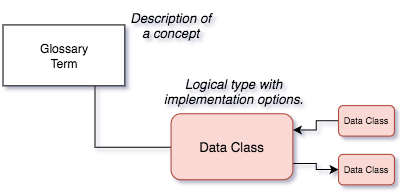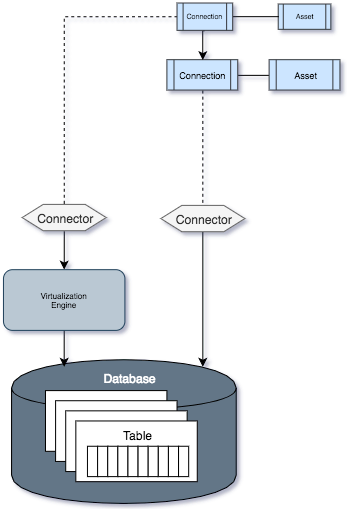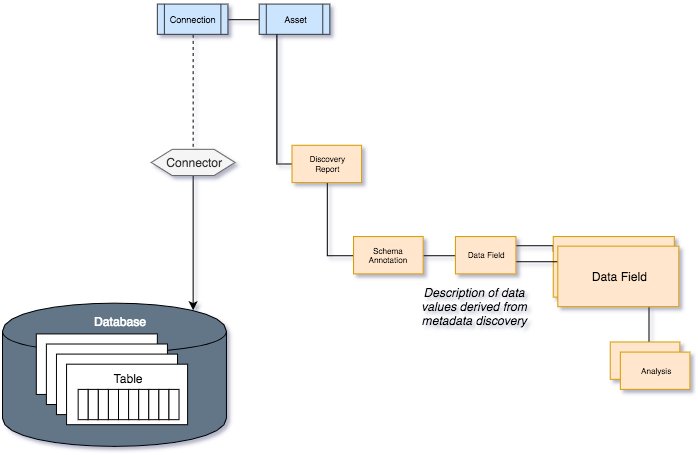Open metadata for common data definitions
The ODPi Egeria project provides a comprehensive set of open metadata types for managing common data definitions. These types provide a common language and format for exchanging these definitions between tools and metadata repositories. Each tool/repository provides a mapping to the ODPi Egeria types and Egeria manages the exchange of metadata between these parties.
The glossary
The glossary is at the heart of the common data definitions. Figure 1 shows that the glossary contains glossary terms. Each glossary term describes a concept used by the business. It is also possible to link two glossary terms together with a relationship. The relationship may describe a semantic relationship or a structural one.

Figure 1: Glossaries for describing concepts and the relationships between them
See anatomy of a glossary for more information about creating glossaries.
Data classes
Data classes provide definitions of
- Logical types
- How to detect them in data
- Preferred implementation types for different technologies
Data classes can be linked together in part-of and is-a hierarchies. For example, Date, Social Security Number, Credit Card Number.
Each data class is linked glossary terms to show how data with that meaning should be represented. This helps to create a candidate list for glossary term assignment recommendations based on the data values stored if they can be matched to a data class.

Figure 2: Data classes for describing the logical data types and implementation options
Schemas
Schemas document the structure of data, whether it is stored or moving through APIs, events and data feeds. There is a schema type that describes a reusable schema. It may be a single primitive field, a set of values, an array of values, a map between two sets of values or a nested structure. The nested structure is the most common. In this case the the schema type has a list of schema attributes that describe the fields in the structure. Each of these attributes has its own schema type that may be primitive, array, set, map or structure in turn.
Figure 3 shows a simple structure schema.

Figure 3: Schemas for documenting the structure of data
Schemas and assets
Since schema types describe the structure of data, they can be attached to assets to indicate that this asset’s data is organized as described by the schema. A single schema type can be attached to multiple assets to show these asset all have data with the same structure (but not necessarily the same data values).

Figure 4: Assets for documenting the organization’s important data assets
Connectors and connections
Assets are accessed through connectors. A Connector is a client library that applications use to access the asset across the network. Typically there is a specialized connector for each type of Asset. Sometimes there are multiple connectors to access a specific type of asset, each offering a different interface for the application to use.
Instances of connectors are created using the Connector Broker. The connector broker creates the connector instance using the information stored in a Connection object. These can be created by the application or retrieved from the metadata repositories.
A connection object is stored in the metadata repository, it is typically linked to the asset that is accessed by the connector that the connection describes.

Figure 5: Connection information needed to access the data held by an asset
Metadata discovery
A discovery engine is a process that runs a pipeline of analytics to describe the data content of an asset. It uses statistical analysis, reference data and other techniques to determine the type and range of values stored, potentially what the data means and its level of quality. The result of the analysis is stored in metadata objects called annotations.

Figure 6: Output from a metadata discovery engine
Bringing it all together
Figure 7 shows each of these pieces linking together. In a real-world environment, the aim is to automate as much of this linkage as possible. This is made considerably easier if the implementation landscape is reasonable consistent. However, where the stored data values do not match the expected types defined in the schema, the metadata model reveals the inconsistencies and often requires human intervention to ensure the links are correct.

Figure 7: Linking the metadata together
License: CC BY 4.0, Copyright Contributors to the ODPi Egeria project.
